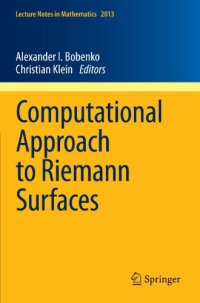
Ebook: Computational Approach to Riemann Surfaces
- Genre: Mathematics // Computational Mathematics
- Tags: Algebraic Geometry, Functions of a Complex Variable, Numerical Analysis
- Series: Lecture Notes in Mathematics 2013
- Year: 2011
- Publisher: Springer-Verlag Berlin Heidelberg
- Edition: 1
- Language: English
- pdf
This volume offers a well-structured overview of existent computational approaches to Riemann surfaces and those currently in development. The authors of the contributions represent the groups providing publically available numerical codes in this field. Thus this volume illustrates which software tools are available and how they can be used in practice. In addition examples for solutions to partial differential equations and in surface theory are presented. The intended audience of this book is twofold. It can be used as a textbook for a graduate course in numerics of Riemann surfaces, in which case the standard undergraduate background, i.e., calculus and linear algebra, is required. In particular, no knowledge of the theory of Riemann surfaces is expected; the necessary background in this theory is contained in the Introduction chapter. At the same time, this book is also intended for specialists in geometry and mathematical physics applying the theory of Riemann surfaces in their research. It is the first book on numerics of Riemann surfaces that reflects the progress made in this field during the last decade, and it contains original results. There are a growing number of applications that involve the evaluation of concrete characteristics of models analytically described in terms of Riemann surfaces. Many problem settings and computations in this volume are motivated by such concrete applications in geometry and mathematical physics.
This volume offers a well-structured overview of existent computational approaches to Riemann surfaces and those currently in development. The authors of the contributions represent the groups providing publically available numerical codes in this field. Thus this volume illustrates which software tools are available and how they can be used in practice. In addition examples for solutions to partial differential equations and in surface theory are presented. The intended audience of this book is twofold. It can be used as a textbook for a graduate course in numerics of Riemann surfaces, in which case the standard undergraduate background, i.e., calculus and linear algebra, is required. In particular, no knowledge of the theory of Riemann surfaces is expected; the necessary background in this theory is contained in the Introduction chapter. At the same time, this book is also intended for specialists in geometry and mathematical physics applying the theory of Riemann surfaces in their research. It is the first book on numerics of Riemann surfaces that reflects the progress made in this field during the last decade, and it contains original results. There are a growing number of applications that involve the evaluation of concrete characteristics of models analytically described in terms of Riemann surfaces. Many problem settings and computations in this volume are motivated by such concrete applications in geometry and mathematical physics.